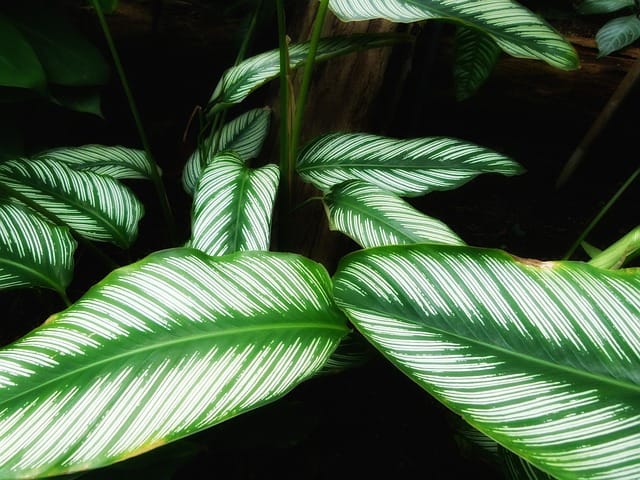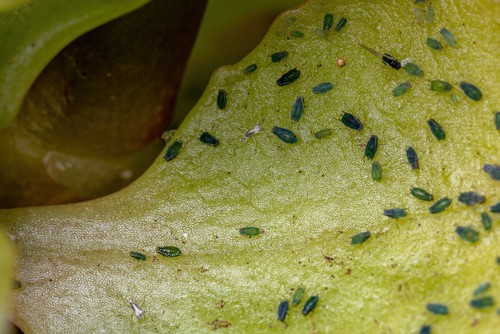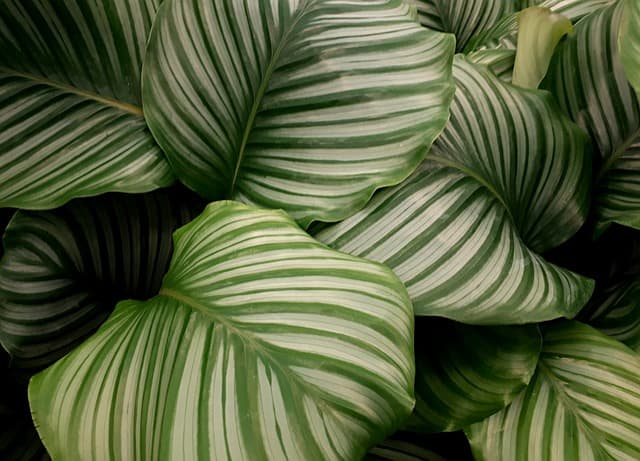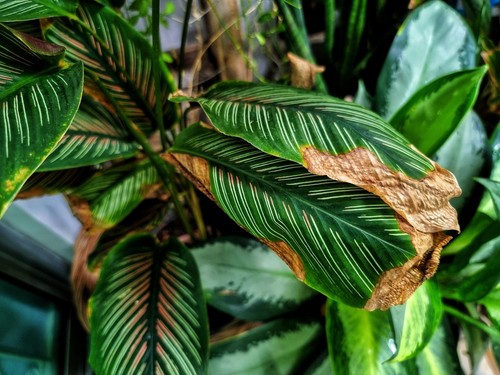Calathea plants are known for their beautiful foliage and unique patterns, making them a popular choice for indoor gardening enthusiasts. However, brown spots on calathea leaves plants can be a cause for concern. These spots can indicate a variety of issues, including overwatering, improper lighting, and pest infestations.
Understanding the unique needs of Calathea plants is essential for maintaining their health and beauty. These plants thrive in high humidity environments and require regular watering to keep their soil moist.
However, too much water can lead to root rot and other issues that can cause brown spots on the leaves. Additionally, Calathea plants prefer indirect light and can suffer from leaf burn if exposed to too much direct sunlight.
Key Takeaways
- Brown spots on Calathea leaves can be caused by a variety of factors, including overwatering, improper lighting, and pest infestations.
- Maintaining the health of Calathea plants requires understanding their unique needs, including high humidity environments and indirect lighting.
- Preventing and treating brown spots on Calathea leaves involves proper watering, pest management, and providing the right environment for the plant to thrive.
Also read:
Understanding Calathea Plants

Calathea plants are a popular choice for indoor gardening enthusiasts. These plants are known for their beautiful foliage and unique leaf patterns. Calatheas are native to South America, and they thrive in humid environments with bright, indirect light.
Calathea plants have a reputation for being fussy, but with the right care, they can be easy to maintain. One of the most common issues that Calathea plant owners face is brown spots on the leaves. Brown spots can be caused by a variety of factors, including diseases, pests, and environmental conditions.
Calathea plants are known for their new growth, which appears as vibrant, colorful leaves. As the plant matures, the older leaves may begin to fade or develop brown spots. This is a natural part of the plant’s growth cycle, and it is not necessarily a cause for concern.
To keep Calathea plants healthy, it is important to provide them with the right conditions. Calatheas thrive in bright, indirect light, and they prefer to be kept in a humid environment. To increase humidity, place a tray of water near the plant or use a humidifier.
When it comes to watering Calathea plants, it is important to strike a balance. Overwatering can lead to root rot, while underwatering can cause the leaves to wilt and dry out. It is best to water Calathea plants when the top inch of soil feels dry to the touch.
Identifying Brown Spots on Calathea Leaves
Calathea plants are known for their beautiful and vibrant foliage, but brown spots on the leaves can be a sign of a problem. Brown spots can be caused by a variety of issues, including diseases, pests, and environmental factors. Identifying the cause of the brown spots is the first step in treating the problem.
One common cause of brown spots on Calathea leaves is leaf spot disease. Leaf spot is a fungal disease that can affect a wide variety of plants, including Calathea.
The disease is characterized by brown or black spots on the leaves, which may be surrounded by a yellow halo. If left untreated, the spots can grow and merge, eventually causing the leaves to turn yellow and fall off.
Another possible cause of brown spots on Calathea leaves is algal leaf spot. This is a type of fungal disease that is caused by a species of algae.
The disease is characterized by small, circular brown spots on the leaves, which may be surrounded by a yellow halo. In severe cases, the spots can merge and cause the leaves to turn yellow and fall off.
Anthracnose and septoria leaf spot are other fungal diseases that can cause brown spots on Calathea leaves. Anthracnose is characterized by brown or black spots with a reddish-brown border, while septoria leaf spot is characterized by small, circular brown spots with a grayish-white center.
Environmental factors can also cause brown spots on Calathea leaves. For example, low humidity can cause the leaves to become dry and brittle, which can lead to brown spots. Excess light can also cause brown spots, as can frost damage.
In some cases, bacterial leaf spot or powdery mildew can also cause brown spots on Calathea leaves. Bacterial leaf spot is characterized by brown or black spots with a yellow halo, while powdery mildew is characterized by a powdery white coating on the leaves.
Overall, identifying the cause of brown spots on Calathea leaves is crucial in treating the problem. Once the cause is identified, appropriate treatment can be applied to prevent further damage to the plant.
Causes of Brown Spots

Brown spots on Calathea leaves can be caused by a variety of factors. The most common causes are overwatering, bad water quality, excessive sun exposure, diseases, and pest problems.
Overwatering is one of the leading culprits when the Calathea has brown spots. When the plant is overwatered, it creates an environment where fungal and bacterial infections can thrive.
This can lead to root rot, which in turn causes discoloration and spotting on the leaves. To avoid overwatering, it is important to only water the plant when the top inch of soil is dry.
Underwatering can also cause brown spots on Calathea leaves. When the plant is not getting enough water, it can become stressed and develop brown spots. To avoid this, it is important to water the plant regularly and keep the soil moist but not soaking wet.
Low humidity is another common cause of brown spots on Calathea leaves. Calatheas need high humidity to thrive, and if the air is too dry, it can cause the leaves to develop brown spots. To increase humidity, it is recommended to mist the leaves regularly or use a humidifier.
Excessive sun exposure can also cause brown spots on Calathea leaves. Calatheas prefer indirect, filtered light and can be damaged by direct sunlight. To avoid this, it is recommended to place the plant in a location with bright, indirect light.
Diseases and pests can also cause brown spots on Calathea leaves. Common pests include spider mites, aphids, and mealybugs, while common diseases include fungal diseases and root rot. To avoid these issues, it is recommended to inspect the plant regularly for signs of infestation or disease and treat them promptly.
Water quality can also play a role in the development of brown spots on Calathea leaves. Poor water quality, such as high levels of minerals or chlorine, can damage the plant. It is recommended to use distilled or rainwater, or to let tap water sit for at least 24 hours before using it to water the plant.
Nutrient deficiencies, such as a lack of nitrogen, copper, phosphorus, or potassium, can also cause brown spots on Calathea leaves. To avoid this, it is recommended to fertilize the plant regularly with a balanced fertilizer.
Prevention and Treatment

Preventing brown spots on Calathea leaves is easier than treating them. Regular monitoring of the plant’s environment and care routine can prevent most issues. Here are some tips to prevent brown spots on Calathea leaves:
- Humidity: Calatheas thrive in high humidity environments. Use a humidifier or place a tray of water near the plant to maintain a humid environment. Misting the leaves occasionally can also help.
- Light: Calatheas prefer bright, indirect light. Avoid placing them in direct sunlight as it can cause brown spots on the leaves. Sheer curtains can be used to filter the light.
- Watering frequency: Overwatering and underwatering are the leading causes of brown spots on Calathea leaves. Water the plant when the top inch of soil is dry. Ensure proper drainage by using pots with drainage holes and a well-draining potting mix.
- Air circulation: Good air circulation can prevent fungal diseases and insect infestations. Avoid placing the plant in drafty areas or stagnant air.
- Pruning: Regular pruning can prevent overcrowding and promote air circulation. Remove any yellow or brown leaves and trim back leggy growth.
If brown spots do appear on the Calathea leaves, here are some treatment options:
- Disease: Brown spots caused by diseases such as leaf spot can be treated with fungicides. Remove any infected leaves and avoid overhead watering to prevent the spread of the disease.
- Pests: Spider mites, aphids, mealybugs, and fungus gnats can cause brown spots on Calathea leaves. Treat the plant with insecticidal soap or neem oil.
- Watering problems: Adjust the watering frequency and check for proper drainage. If the soil is too moist, let it dry out before watering again.
- Fertilizer burn: Brown spots caused by fertilizer burn can be treated by flushing the soil with water. Avoid fertilizing the plant for a few months.
- Roots: Brown spots caused by root rot can be treated by repotting the plant in fresh soil. Trim any damaged roots and ensure proper drainage.
- Water quality: Brown spots caused by cold or hard water can be prevented by using distilled water or rainwater. A water filtration system can also be used.
- Environmental factors: Curled or crispy leaves can be caused by temperature fluctuations, dehydration, or exposure to drafts. Adjust the plant’s environment accordingly.
Recovery Process

Once the underlying issue causing brown spots on Calathea leaves has been identified and addressed, the plant can begin its recovery process.
One of the first signs of recovery is the emergence of new growth. As the plant heals, it will produce new leaves that are free of brown spots. It’s important to note that these new leaves may take some time to grow and fully replace the damaged ones.
In some cases, pruning may be necessary to remove severely damaged leaves and encourage new growth. When pruning, make sure to use clean, sharp scissors or shears to avoid further damage to the plant.
Repotting can also aid in the recovery process, especially if the brown spots were caused by root rot or other soil-related issues. When repotting, make sure to use a well-draining soil mix and a pot with adequate drainage holes.
To promote healthy growth and prevent future brown spots, consider using a pebble tray or increasing humidity levels. Placing the plant on a tray filled with pebbles and water can help increase humidity levels around the plant. Alternatively, using a humidifier or misting the plant regularly can also help maintain adequate humidity levels.
It’s important to ensure that the soil remains moist but not waterlogged, as overwatering can lead to further issues. Allowing the soil to dry out slightly between waterings can help prevent fungal growth and other issues.
Fertilizer burn can also cause brown spots on Calathea leaves, so it’s important to be mindful of fertilization practices. If using a fertilizer, make sure to dilute it properly and apply it according to the manufacturer’s instructions.
Finally, ensuring that the plant is in a suitable environment with appropriate temperature, lighting, and air circulation can also aid in the recovery process. Calathea plants prefer indirect light and temperatures between 65-80°F. Adequate air circulation can help prevent fungal growth and other issues.
By addressing the underlying issue and promoting healthy growth conditions, Calathea plants can recover from brown spots and continue to thrive.
Frequently Asked Questions
How do you treat brown spots on Calathea?
Treating brown spots on Calathea involves identifying the cause first. If the brown spots are caused by overwatering, the plant should be allowed to dry out before watering again. If the spots are caused by underwatering, the plant should be watered more frequently.
If the plant is receiving too much direct sunlight, it should be moved to a location with indirect sunlight. If the humidity is too low, a humidifier or a pebble tray can be used to increase the humidity around the plant.
If the plant is affected by pests, they should be removed using appropriate methods.
Why does my Calathea have brown spots on the leaves?
Calathea leaves can develop brown spots due to a variety of reasons, including overwatering, underwatering, direct sunlight, low humidity, pests, or poor water quality. Identifying the cause of the brown spots is important to treat the plant effectively.
What does an overwatered Calathea look like?
An overwatered Calathea may have yellowing leaves, soft or mushy stems, and a foul smell. The soil may also be soggy and have a bad odor. Overwatering can lead to root rot, which can be fatal to the plant.
What are the leaf spots on Calathea?
Leaf spots on Calathea can be caused by various factors, including fungal or bacterial infections, pests, or physical damage.
Fungal or bacterial infections can cause circular or irregular brown spots on the leaves, while pests can cause small holes or yellowing spots. Physical damage can cause brown spots or holes on the leaves.
How do you fix brown leaves on Calathea?
Fixing brown leaves on Calathea involves identifying the cause first. If the brown leaves are caused by overwatering, the plant should be allowed to dry out before watering again.
If the leaves are affected by pests, they should be removed using appropriate methods. If the plant is receiving too much direct sunlight, it should be moved to a location with indirect sunlight.
If the humidity is too low, a humidifier or a pebble tray can be used to increase the humidity around the plant.
What are common diseases that affect Calathea leaves?
Common diseases that affect Calathea leaves include fungal or bacterial infections, such as leaf spot, powdery mildew, or bacterial blight. These diseases can cause brown spots, yellowing, or wilting of the leaves.
Pests, such as spider mites, mealybugs, or scale insects, can also affect Calathea leaves and cause damage.

Hey, I’m Lisa and I’ve been an avid gardener for over 30 years. I love writing, talking and living in the garden! Feel free to connect with me on my socials below

